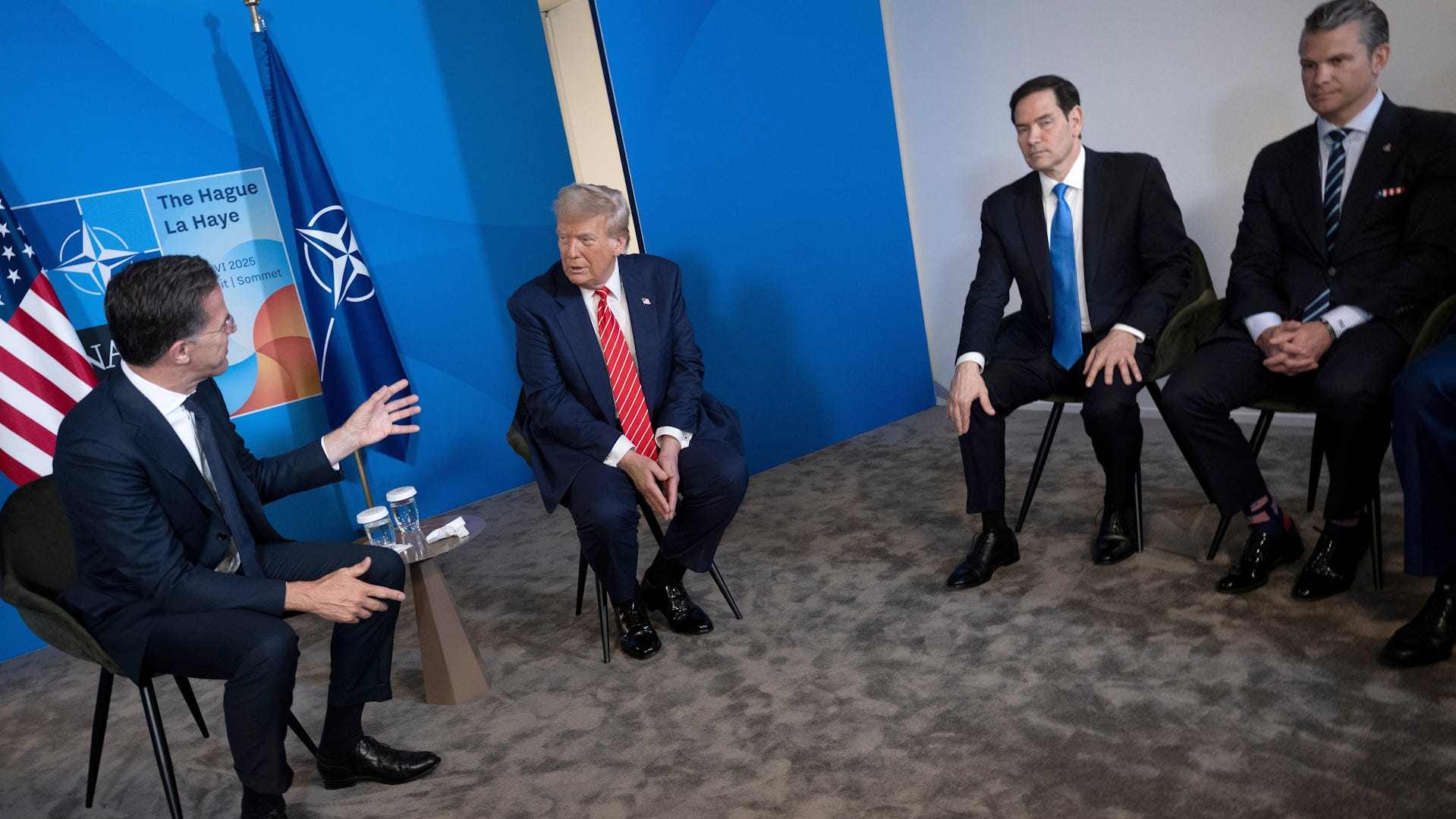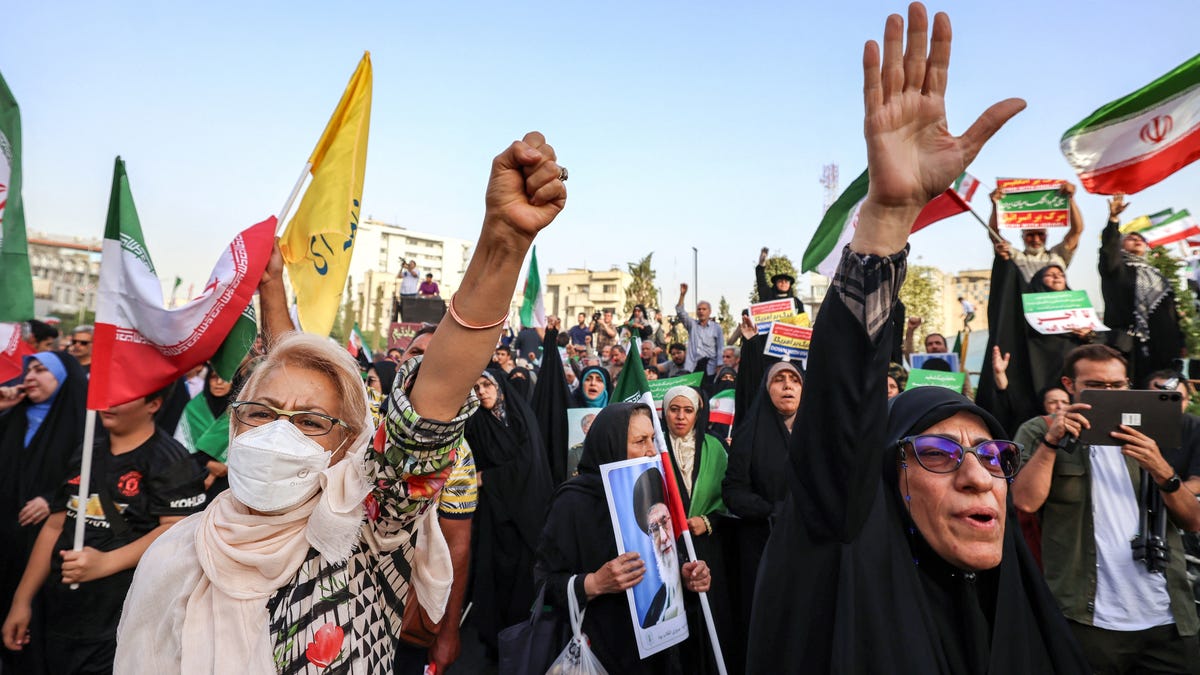
President Trump contradicts Pentagon’s Iran damage report
President Donald Trump pushed back on reports indicating the U.S. attack on Iran’s nuclear facilities was not as successful as originally claimed.
The Trump administration believes the deadly, 12-day conflict between Israel and Iran is over and will not restart, President Donald Trump said June 25.
“We think it’s over. I don’t think they’re going to be going back at each other,” Trump said at a news conference closing out a NATO summit in The Netherlands, adding that his team will speak with Iranian leaders next week.
Trump went as far as comparing the American attack on Iranian nuclear facilities over the weekend to the U.S. dropping two atomic bombs on Japan in 1945 at the conclusion of World War II.
“When you look at Hiroshima, if you look at Nagasaki, that ended a war, too,” Trump said. “This ended a war in a different way.”
Trump spent his final day at NATO disputing leaked intelligence that assessed the U.S. strikes set Iran’s nuclear program back by months, not years, as he and other members of his administration have been claiming.
The Trump administration maintains that three key uranium enrichment sites – Fordow, Natanz and Isfahan – were totally destroyed by U.S. airstrikes, which Trump said was supported by satellite imagery of the locations. Trump said the Pentagon assessment was not finished and provided an incomplete picture of the situation.
“They didn’t see it. All they could do was take a guess,” Trump said of the intelligence assessment. He later posted this on social media: “We’ve collected additional intelligence, and we’ve also spoken to people who have seen the site − and the site is obliterated!”
NATO’s European members pledged June 25 to more than double their military spending over the next decade, to 5% of their gross domestic product. The agreement, more a goal than finite percentage, is a bow to Trump’s long-held complaint that Europe should pay more of NATO’s bills.
“This is a monumental win for the United States because we were carrying much more than our fair share,” Trump said. “This is a big win for Europe and actually for western civilization.”
The plan is for spending 3.5% on military equipment and 1.5% on infrastructure upgrades such as roads, ports, bridges and airfields. Spain’s Prime Minister Pedro Sánchez said his country won’t comply, and Trump said the US. would address that issue with its trade deal with Spain.
Trump said it was important that Europe spend the additional defense funds on “very serious military hardware, not bureaucracy.” And he suggested America would be a good place for Europe to shop for its weaponry. He used Iran’s assault on a U.S. air base in Qatar as an example of U.S. military might. Fourteen missiles were fired at the base, 13 were shot down and one fell harmlessly far from its target, he has said.
“They were very nice, they gave us warning. They said, ‘We are going to shoot them, is 1 o’clock OK?'” Trump said, drawing laughter at his NATO news conference. “We said, ‘It’s fine.’ Everybody was emptied off the base so they could not get hurt.”
Iran and Israel were both claiming victory in the short but deadly conflict as the world waited to determine whether a ceasefire would hold.
Israeli Prime Minister Benjamin Netanyahu said his country had achieved the goals of its attacks on Iran by destroying the nation’s nuclear program. Israel’s Atomic Energy Commission on June 25 issued an assessment of the damage, saying Iran’s nuclear program has been set back “many years.”
A Pentagon intelligence assessment was less definitive, saying the 30,000-pound weapons may not have reached deep enough to destroy the underground installations and likely only delayed Iran’s nuclear program by a few months. Trump said Wednesday the intelligence was inconclusive.
“The intelligence says we don’t know. It could’ve been very severe, that’s what the intelligence suggests,” Trump told reporters while meeting with NATO Secretary General Mark Rutte. “It was very severe. There was obliteration.”
Defense Secretary Pete Hegseth, speaking at the NATO summit June 25, said the FBI was investigating the leak of the Pentagon intelligence assessment, which he said was “top secret.”
“It was devastation,” Hegseth said at a briefing with Trump. “Any assessment that tells you it was something otherwise is speculating with other motives.”
Hegseth said the assessment was preliminary, low confidence and for “internal purposes.” He said it estimated the damage was “moderate to severe and we believe far more likely severe and obliterated.”
Israel’s Atomic Energy Commission says the combination of U.S. and Israeli assaults on Iran’s nuclear sites set back Iran’s program “many years” and possibly “indefinitely.”
“The devastating US strike on Fordow destroyed the site’s critical infrastructure and rendered the enrichment facility inoperable,” the agency said in a report. “We assess that the American strikes on Iran’s nuclear facilities, combined with Israeli strikes on other elements of Iran’s military nuclear program, has set back Iran’s ability to develop nuclear weapons by many years.”
The report said the “achievement can continue indefinitely” if Iran is kept from gaining access to nuclear material.
The attack resulted in “extensive damage” to Iran’s uranium conversion and enrichment facilities, according to the International Atomic Energy Agency, the United Nations’ nuclear watchdog.
Director General Rafael Mariano Grossi said the agency’s early report shows some “localized radioactive as well as chemical release” inside the facilities that contained nuclear material – mainly enriched uranium. But there has been no report of increased off-site radiation, he said.
The IAEA is aware of concerns in the region regarding radiological consequences as a result of the strikes, he said.
“Based on the data available to us, the IAEA can provide assurances that there has been no radiological impact to the population and the environment in neighboring countries. Crucially in terms of nuclear safety, Iran’s research and power reactors were not targeted,” Grossi said.
Iran on Wednesday executed three Kurdish men accused of helping Israel’s Mossad spy agency conduct assassinations inside the country. The semi-official Tasnim news agency said the three had been caught trying to “import equipment into the country under the guise of a shipment of alcoholic beverages.”
The Oslo-based group Iran Human Rights said the three were executed at Urmia prison “without a fair trial and based on confessions obtained under torture,” adding that Iran is conducting hangings as a form of suppression to cover up military failures in its war against Israel.
Two of the men executed were kolbars, or border mules, “who were arrested on charges of smuggling alcoholic beverages but were forced to confess to espionage for Israel,” the group said.
Tasnim reported the defendants had smuggled equipment that “ultimately led to the assassination” of a government figure. The report did not specify whose assassination they had allegedly assisted. Israel killed numerous top Iranian military officials and nuclear scientists in the opening salvo of its 12-day war with Iran. The three were convicted of “enmity against God” and “corruption on earth,” Tasnim reported.
− Dan Morrison
The saga between Iran and the United States goes back seven decades and 13 presidents, a relationship that broke down after the people of Iran rose up in 1978 against a regime the United States helped install in 1953. While Trump’s decision to bomb the country’s nuclear sites has Americans on edge, the United States has a long history of punishing Iran’s government, most often through sanctions.
At the center of it all is the state of Israel, the United States’ key ally in the region − one that consistently finds itself at war with Iran or with the Islamic extremist groups that are proxies for Iran’s interests. For some key moments in the relationship between the U.S. and Iran, read more here.
In Iran, the Supreme National Security Council declared that the Islamic Republic’s military response to the attack forced Israel and its Western supporters to unilaterally halt offensive operations. And Iran’s top nuclear official, Mohammad Eslami, told the Mehr News Agency that preparations made ahead of the attack will prevent any hiatus in progress for Iran’s nuclear industry.
Israel’s sweeping assault, which began June 13, targeted military leaders, nuclear scientists, uranium enrichment facilities and Iran’s ballistic missile program.
The war has been costly. Iranian Health Minister Mohammad Reza Zafarqandi said more than 600 Iranians have been killed by Israeli missiles. Iran’s missile attacks in response killed about 30 and wounded thousands in Israel, severely damaging apartment buildings, a university and a hospital, according to the Times of Israel.
Some residents and tourists in major American cities say they feel uneasy about the possibility of violence breaking out at home. At New York’s Penn Station, Catherine Wagoner, a kindergarten teacher from Boston waiting for her train home after visiting friends, told USA TODAY she felt less safe traveling since the attacks in Iran.
“Being in New York feels more of a threat – more of a target,” she said, adding, “I definitely have a lot of privilege, and I don’t feel like I’m necessarily the target, so I can recognize that. But I just have a constant state of anxiety about the state of the world.”
Wagoner’s feelings were echoed in a recent Reuters/Ipsos poll that surveyed 1,139 U.S. adults nationwide and found that some 79% of respondents said they worried “that Iran may target U.S. civilians in response to the U.S. airstrikes.” Read more here.
− Christopher Cann and Michael Collins
The U.S. intelligence community has been consistent: It does not believe Iran has been building a nuclear weapon. U.S. Director of National Intelligence Tulsi Gabbard said as much when she testified to Congress about Iran’s nuclear program in March.
U.S. spy agencies, Gabbard said, “continue to assess that Iran is not building a nuclear weapon and Supreme Leader Khamenei has not authorized the nuclear weapons program he suspended in 2003.”
Trump and Netanyahu dismissed that assessment. Trump has doubted U.S. intelligence agencies before − for example, over who was responsible for the murder of Washington Post columnist Jamal Khashoggi (it was Saudi Arabia). Netanyahu, meanwhile, has been talking about Iran’s existential nuclear threat to Israel for as along as he’s been in the public eye.
Still, U.S. intelligence agencies, Trump, Netanyahu and the United Nations’ nuclear watchdog − the International Atomic Energy Agency − agree on the issue of Iran’s uranium.
All believe Iran has developed a large stockpile, and at a sufficiently enriched level, to sustain a nuclear reaction that could be used in a bomb if it decided to. But how quickly Iran could then “sprint to a nuclear weapon,” as Gen. Michael E. Kurilla put it on June 10, is also a matter of dispute, and estimates range from one week to one year.
−Kim Hjelmgaard
Trump ordered the strikes on Iran’s nuclear facilities − Operation Midnight Hammer − effectively joining a war that Israel started on June 13 when it began bombing Iranian nuclear and military infrastructure. Israel said it helped the U.S. coordinate and plan the strikes.
Trump said all three sites were “totally obliterated.” But an independent assessment has not yet been carried out. The International Atomic Energy Agency − the United Nation’s nuclear watchdog − released a statement saying that so far it had not detected an increase in “off-site radiation levels,” one of the feared consequences of the strikes.
Contributing: Reuters
